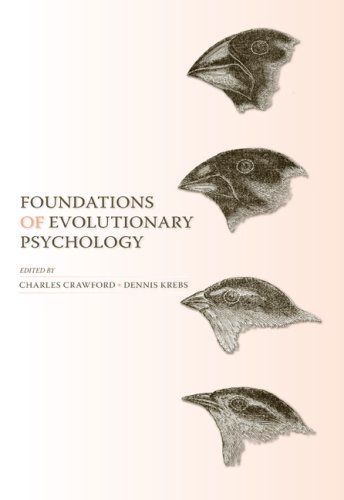Foundations of Evolutionary Psychology 2nd Edition by Charles Crawford,Dennis Krebs 0805859578 9780805859577
$50.00 Original price was: $50.00.$35.00Current price is: $35.00.
Foundations of Evolutionary Psychology 2nd Edition by Charles Crawford,Dennis Krebs – Ebook PDF Instant Download/Delivery:0805859578 ,9780805859577
Full download Foundations of Evolutionary Psychology 2nd Edition after payment
Product details:
ISBN 10:0805859578
ISBN 13: 9780805859577
Author:Charles Crawford,Dennis Krebs
Evolutionary psychology is concerned with the adaptive problems early humans faced in ancestral human environments, the nature of the psychological mechanisms natural selection shaped to deal with those ancient problems, and the ability of the resulting evolved psychological mechanisms to deal with the problems people face in the modern world. Evolutionary psychology is currently advancing our understanding of altruism, moral behavior, family violence, sexual aggression, warfare, aesthetics, the nature of language, and gender differences in mate choice and perception. It is helping us understand the relationships between cognitive science, developmental psychology, behavior genetics, personality, and social psychology.
Foundations of Evolutionary Psychology provides an up-to-date review of the ideas, issues, and applications of contemporary evolutionary psychology. It is suitable for senior undergraduates, first year graduate students, or professionals who wish to become conversant with the major issues currently shaping the emergence of this dynamic new field. It will be interesting to psychologists, anthropologists, sociologists, economists, philosophers, cognitive scientists, and anyone interested in using new developments in the theory of evolution to gain new insights into human behavior.
Foundations of Evolutionary Psychology 2nd Table of contents:
1 Evolutionary Psychology The Historical Context
Evolutionary Thinking before Darwin
Darwin’s Insights
The Early Enthusiasts (Darwin’s Influence on Nonpsychologists)
Why did the ideas of the early enthusiasts fade?
Eugenics, Behaviorism, and Environmentalism
Rediscovering Darwin (The Biologists)
Heralds of Modern Evolutionary Thinking
Evolutionary Psychology
Current Issues in Evolutionary Psychology
Why the Wariness?
Summary
References
Part I Biological Foundations of Evolutionary Psychology
2 Evolutionary Questions for Evolutionary Psychologists
What Theory Provides the Foundation for Evolutionary Psychology?
Is Evolutionary Psychology Fundamentally Different from Sociobiology?
Is Natural Selection Theory a Circular Argument?
Is Sexual Selection Fundamentally Different from Natural Selection?
What is More Important to the History of a Species: Selection for Individual Reproductive Success or Selection for Group Survival?
What is the Unit of Selection: The Gene or the Individual?
Does Natural Selection Lead to Evolutionary Progress?
Is Everything an Adaptation?
Are Adaptationists Just-So Story Tellers?
Is it True, However, That Adaptationists Greatly Overestimate the Prevalence of Adaptation?
But are Adaptations Often Less than Optimal Because of the Constraints Placed on Them by the Evolutionary Process?
In the Case of Humans, Should Sociocultural Explanations for Our Behavior Take Precedence Over Evolutionary Ones?
Given that We Know So Little about the Ancestral Environment of Humans, How Can We Know Anything about the Selection Pressures Operating on Our Ancestors?
Summary
References
3 Life History Theory and Human Development
Introduction
The Comparative Evidence: Humans Among Primates
How to Construct an Evolutionary Explanation of a Life History
The Historical Explanations of Macroevolution
The Selection Explanations of Microevolution
The Mechanistic Explanations of Development and Physiology
Evolutionary Explanations of the Major Life History Traits
Critical Early Events Involving Gametes and Embryos
Selection Arenas, Oocytic Atresia, and Menopause
Sperm Selection
Spontaneous Abortion
Conflicts over Intrauterine Growth
Size at Birth
Growth and Maturation
Human Growth Patterns
Optimal Age and Size at Maturity
The Patterning of Reproductive Investment After Puberty
Interbirth Intervals
Single Versus Multiple Births
Sex Allocation
Bet-Hedging and Risk Minimization
Infanticide
Menopause
Life Span and Aging
Development and Physiology
Developmental Determinants of Adult Survival and Reproduction
Sex Hormones: Trade-offs, Morphology, and Buffering
Discussion
References
4 Sex and Sexual Selection
The Evolution of Sex and Its Implications
Definition of Sex
Current Theories of Evolution of Sex
How Many Sexes
Characteristics of Males and Females
Gamete Size and Numbers
Parental Investment and Potential Rates of Reproduction
Sex Differences in Rate of Mutation and Their Consequences
Sex-Specific Transmission of Organelles
Sexual Selection
Sexual Signals and their Reliability
Benefits of Mate Choice
Sexual Conflict
Sperm Competition
Differential Parental Investment
Sex Ratio and Sex Ratio Manipulation
Humans as a Sexually Selected Species
Summary
References
5 Kinship and Social Behavior
Social Behaviors
Language
Kin Selection, Cooperation, and Altruism
Kin Selection More Generally
What is relatedness?
How does kin selection work?
Kin Discrimination
Limited Dispersal
Measuring Relatedness
Testing Kin Selection Theory: Quantitative Hamilton’s Rules
Testing Kin Selection Theory: Comparative Statics
Kin Selection and Conflict between Individuals
Parent-Offspring Conflict
Sibling Conflict
Kin Selection and Genomic Imprinting
Competition and Cooperation
Old Group Selection
New Group Selection
Kin Selection, Cooperation and Altruism—Revisited
Conclusions
Acknowledgments
References
Part II Development: The Bridge from Evolutionary Theory to Evolutionary Psychology
6 Sociogenomics for the Cognitive Adaptationist
Background
Mendelian Fairness
Gene frequency and evolutionary change
From DNA to Behavior
Genes as Strategists
Theoretical Genetics
The modern synthesis
Phenotypic plasticity20
Population genetics and game theory
Sociogenomics I Genomic imprinting
Neurogenetics and the Candidate Gene Approach
Sociogenomics II Indirect genetic effects
Sociogenomics III Maternal epigenetics
Development
Developmental constraints
Evolutionary Psychology: Domains, Levels and Challenges22
Is evolutionary psychology necessarily a form of nativism?
Are evolutionary psychologists only interested in universals?
Is the gene the sole unit of selection?
Gene to Organism Domain-Specificity?
Acknowledgments
References
7 Selfish Genes, Developmental Systems, and the Evolution of Development
Relationships Between Evolutionary and Developmental Theory in the 19th and Early 20th Centuries
The Modern Synthesis, the Rise of “Selfish Genes,” and Evolutionary Views of Human Development Emerging in the Late 20th Century
Theme 1
Theme 2
Theme 3
The Introduction of Developmental Systems Theory
The Search for a General Theory of the Relationship Between Evolution and Development
A General Theory of the Evolution of Development
Summary and Concluding Remarks
Author Note
Acknowledgments
References
Part III Evolved Mental Mechanisms: The Essence of Evolutionary Psychology
8 Biological Adaptations and Human Behavior
Fundamental Concepts
Traits and Effects
Adaptations and Functions
Effects, Selection, and Evolution
The Concepts of Adaptation and Function
An Alternative Concept of Function
By-Products
Exaptation and Fortuitous Effects
The Concept of Exaptation
Secondary Adaptation
Is the Concept of Exaptation Useful?
Constr Aints
The Costs of Traits
Genetic and Developmental Constraints
Adaptationist Methodology
How to Identify Adaptation
Special Design
Arguments of Design
How Is “Good Design” Assessed?
The Nature of Psychological Adaptations
The Problem of Exapted Learning Mechanisms
The Role of Comparative and Phylogenetic Analyses for Establishing Adaptation
Some Outstanding Issues Pertaining to Adaptation
Issue 1 The Problem of Atomizing Traits
Issue 2 Is Current Fitness Relevant After All?
Issue 3 Reverse Engineering Versus Reverse Tinkering
Issue 4 Organisms Create Environments
Summary
References
9 Evolved Cognitive Mechanisms and Human Behavior
The Explanatory Role of Mechanisms in Evolutionary Psychology
The Form-Function Fit, Design Features, and Domain Specificity
The Empirical Study of Specialized Cognitive Mechanisms
Face Recognition
Mechanisms for Inferring the Intentions of Others
Kin Recognition and Mechanisms Regulating Interactions with Kin
The Social Exchange System
Other Mechanisms: Learning, Regulatory, and Interface Mechanisms
General Principles
Explaining the Seamless Whole of Behavior
References
10 Adaptations, Environments, and Behavior Then and Now
Innate Genetic Specialized Genetic Organization
Adaptations and their Functioning
Scorpionfly Mating Illustrates Concurrently Contingent Tactics
The Bluegill Sunfish
Fever
Incest Avoidance
Characteristics of Adaptations
Adaptations and Behavior
Decision Makers
Cost-Benefit Structure
The Unit of Selection
Adaptation Defined
The Incest Avoidance Adaptation: Then and Now
Reproductive Success
The Genetics of Adaptations
Sex Differences in Life History
Genetic Variation and Natural Selection
Adaptation Functioning: Then and Now
Research Methodologies
Conclusion
References
11 Evolutionary Psychology Research Methods
Evolutionary Psychology Research Methods
Evolutionary Psychology and Identifying Human Psychological Adaptations
Evolutionary Research Methods for Identifying Psychological Adaptation
Formally Evaluating Evidence of Psychological Adaptation
Pregnancy Sickness as a Psychological Adaptation
Research Methods and Adaptations Across Psychological Science
References
Part IV The Evolutionary Psychology of Sex Differences
12 Physical Attractiveness Signals of Phenotypic Quality and Beyond
The Evolution of Attractiveness: Theoretical Considerations
Attractiveness and Beauty Outcomes of Selection
Sexual Selection and Signaling Theory
Are Honest Signaling Systems of Quality Ubiquitous?
Genetic Versus Direct Benefits
Multiple Signals
Mutual Mate Choice
Intrinsic Good Genes and Compatible Genes
Nonsignaling Systems
The Attractiveness of Sexually Dimorphic Features
Facial Sexual Dimorphism
The Attractiveness of Female Facial Femininity
Attractiveness in Relation to Male Facial Masculinity
Sexually Dimorphic Body Features
Female Body Form
Male Physique
The 2D:4D
Other Preferred Facial Traits: Averageness and Symmetry
Facial Averageness
Facial Symmetry
Preferences for Mhc: Compatibility and Heterozygosity
MHC Compatibility
MHC Heterozygosity
The Conditional Nature of Preferences
Conclusion
References
13 Two Human Natures How Men and Women Evolved Different Psychologies
Introduction
Natural Selection and Sexual Selection
The Evolution of Sex Roles
Long-Term and Short-Term Matings
Psychological Sex Differences
Readiness to Mate and Number of Sexual Partners Desired
Economic parental investment
Risk-Taking and Aggression in Intrasexual Competition
The Dual Action of Natural and Sexual Selection on Traits
Wood and Eagly’s (2002) Biosocial Theory
Conclusion
References
14 Heroes and Hos Reflections of Male and Female Sexual Natures
Unobtrusive Measures
The World of Pornography for Men
The Ho
The Romance Novel
The Romance Hero
Why the Big Difference Between Erotica for Men and Women?
Final Thoughts
References
Part V The Evolutionary Psychology of Prosocial Behavior
15 How Selfish by Nature?
The Selfishness of Evolved Dispositions
Biological Selfishness
Psychological Selfishness
Possible Relations Among Genetic, Biological, and Psychological for Ms of Selfishness and Unselfishness
Conclusions
The Evolution of Biologically Selfish and Unselfish Dispositions
The Selection of Dispositions to Behave in Biologically Selfish Ways
The Selection of Dispositions to Behave in Biologically Cooperative Ways
The Selection of Dispositions to Behave in Biologically Altruistic Ways
The Evolution of Psychologically Selfish and Unselfish Dispositions
The Selection of Psychologically Selfish Dispositions
Adaptive Limitations of Short-Sighted Selfishness
The Selection of Psychologically Cooperative Dispositions
Seeking to Maximize Mutual Benefits
Seeking to Reciprocate
Seeking to Foster Fair Outcomes
The Selection of Psychologically Altruistic Dispositions
Empathically Induced Altruistic Motives
Conclusion
References
16 Gene-Culture Coevolution and the Emergence of Altruistic Behavior in Humans
Introduction
Experimental Game Theory
Char Acter Virtues and Human Nature
Altruistic Punishment: The Ultimatum Game
The Public Goods Game
Altruistic Third-Party Punishment
The Evolutionary Stability of Strong Reciprocity
Gene-Culture Coevolution
Is Strong Reciprocity and Adaptation?
Did Strong Reciprocity Evolve Through Group Selection or Individual Selection?
Psychological and Behavior al Aspects of Altruism: Prosocial Emotions and Strong Reciprocity
The Internalization of Nor Ms
Conclusion
References
17 Renaissance of the Individual Reciprocity, Positive Assortment, and the Puzzle of Human Cooperation
Darwin’s Puzzle
Kin Selection (and Genic Self-Favoritism in General)
Reciprocal Altruism
Indirect Reciprocity
Costly Signaling
The New Puzzle of Cooper Ation
First Disagreement: Do the Experimental Data Refute Individual-Level Adaptationist Theories of Human cooperation?
Second Disagreement: Could Selection Have Favored Individual-Level Adaptations for cooperation in Humans?
Group Selection Versus Parsimony
Back to Square One: An Individual-Level Adaptationist Explanation of Cooper Ation in Groups
The Fork in the Road
Proximate Causation
Replacing Binary Reciprocity with Continuous Reciprocity
Some Notes on Interpretation of the Model Results
Rethinking Positive Assortment
Where Does the Evidence Point? Support for the Individual-Level Adaptationist View
Conditional cooperation in Public Good Games
Signaling Cooperativeness Initially and the Decay of Cooperativeness Over Repeated Rounds
Mutual Monitoring
Positive Assortment Via Partner Choice
Reputation
Conclusions
References
18 Cooperation and Conflict between Kith, Kin, and Strangers Game Theory by Domains
Modularity and Solutions to Recurring Social Problems
Recasting the Classic Prisoner’s Dilemma
How Domain-Specific Biases Might Alter Cooperative Trade-Offs
Alliance Formation
Cooperating With Kin
Dyadic Alliances With Nonkin
Status
Self-Protection and Groups
Mate Selection
Mate Retention
Parental Care
Discussion
Acknowledgments
References
19 On the Evolution of Moral Sentiments
The Mystery of Cooperation in One-Shot Social Dilemmas
A Simple Thought Experiment
Mimicry and a Signal’s Problematic First Step
Concluding Remarks
References
Part VI The Evolutionary Psychology of Antisocial Behavior and Psychopathology
20 Is the “Cinderella Effect” Controversial? A Case Study of Evolution-Minded Research and Critiques Thereof
The Evidence
Are Cinderella Effects By-Products of Other Risk Factors Associated With Stepparenthood?
Stepfathers or “Mothers’ Boyfriends”?
Stepparents or Stepfathers?
Mundane (Nonabusive) Discrimination Against Stepchildren
The Controversy
Could Cinderella Effects Be Artifacts of Biased Reporting?
Scholarship and Civility
References
21 Intergroup Prejudices and Intergroup Conflicts
An Evolutionary Perspective on Threats and Prejudices
The Nature of Group and Intergroup Relations During Ancestral Times
Other Primate Populations
Contemporary Human Hunter-Gatherer Populations
Adaptive Features of Intergroup Cognition and Emotion
Costs, Benefits, and Functional Flexibility
Implications for Contemporary Stereotypes, Prejudices, and Conflicts
Variation in the Acquisition and Activation of Fearful Intergroup Cognitions
Instigation and Persistence of Intergroup Conflict
Additional Threats, Additional Prejudices, Additional Implications
The Threat of Parasite Transmission
Threats to the Efficiency of Group Processes
Final Thoughts
References
22 The Evolution of Brain Mechanisms for Social Behavior
Empathizing
Developmental Dissociations
Sex Differences in Empathizing—a Clue to Its Evolutionary Origins?
Natural Selection of Good Empathy Among Females?
Systemizing
Sex Differences in Systemizing
What Is the Evidence for a Stronger Drive to Systemize in Males?
Fetal Testosterone as an Organizer of Brain Development and Sexual Dimorphism
The Cambridge Fetal Testosterone Project
Brain Types
Autism: Hyper-Systemizing Alongside Impaired Empathizing?
The Systemizing Mechanism
Conclusions
Acknowledgements
References
23 An Evolutionary Theory of Mind and Mental Illness: Genetic Conflict and the Mentalistic Continuum
Mentalistic and Mechanistic Cognition
Attention, Intention, and Central Coherence
The Evolutionary Genetics of Mentalism
Hyper-Mentalism and Psychosis
Mentalism and the Mother
Males and Mechanistic Mentality
The X Factor in Psychosis
Acknowledgment
References
24 Psychopathology and Mental Illness
Introduction
Basic Points
The Concept of Mental Disorder
Novel Environments and the Function of Emotions
The Evolutionary Origin of Symptoms
Sexual Selection and Psychiatric Disorders
The Epidemiology of Sexual Disorders
The Impact of Reproductive-Related Trauma
The Impact of Interpersonal Stressful Life Events
Life History Theory and Psychiatric Disorders
Limitations
Lax Adaptationism
Neglect of Behavior Analysis
Therapeutic Irrelevance
References
Part VII Exploring the Explanatory Power of Evolutionary Psychology
25 The Evolutionary Psychology of Religion
Introduction: Religion as an Evolutionary By-Product
The Supernatural Agent: Hair-Triggered Folk Psychology
Cultural Survival: Memory Experiments with Counterintuitive Beliefs
Metarepresenting Counterintuitive Worlds: A Theory of Mind Experiment
Existential Anxiety: An Experiment on What Motivates Religious Belief
Sacred Values in Decision Making and the Limits of Reason
Conclusion: Religion is Humankind’s Provisional Evolutionary Destiny
People also search for Foundations of Evolutionary Psychology 2nd :
foundations of evolutionary psychology
foundations of psychology northeastern
founders of evolutionary psychology
foundations of psychology
foundations of psychology quizlet
Tags:
Charles Crawford,Dennis Krebs,Psychology,Evolutionary,Foundations




